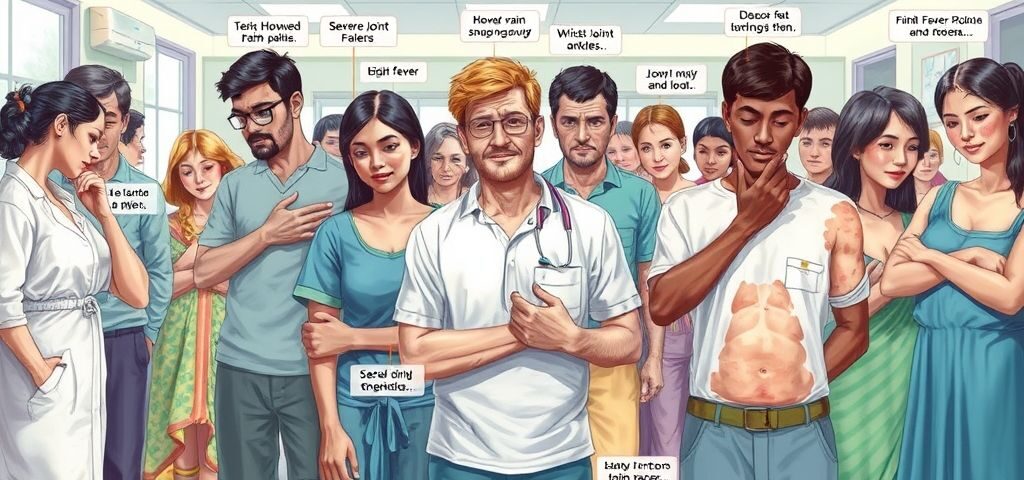Chikungunya virus has made a strong comeback in recent years, especially in tropical and subtropical regions, sparking global health concerns. Once thought to be limited to certain geographic zones, this mosquito-borne illness is now found in countries far beyond its traditional borders due to climate change and global travel. Chikungunya Virus Symptoms
If you or your loved ones are traveling, living in, or working in areas with mosquito populations, it’s vital to recognize chikungunya virus symptoms early for prompt medical care.
What is the Chikungunya Virus?
Chikungunya is caused by a virus transmitted primarily by Aedes aegypti and Aedes albopictus mosquitoes. The word “chikungunya” originates from the Makonde language, meaning “to become contorted,” referencing the stooped posture of those suffering from joint pain caused by the disease.
How is it Transmitted?
Mosquito bites from infected Aedes species
Rarely, from mother to newborn during birth
Not spread through direct human contact, like coughing or sneezing
The incubation period ranges from 2 to 7 days after being bitten. Symptoms often begin suddenly and can last from a few days to several weeks, depending on the individual’s immune response.
Main Content: Chikungunya Virus Symptoms – Complete Breakdown
Early Symptoms: First 3-5 Days
Early detection can reduce complications. These symptoms usually resemble other viral infections, but chikungunya has its unique characteristics.
High Fever (Above 102°F or 39°C)
Often, the first sign it begins suddenly and can last 2–4 days.
Severe Joint Pain (Polyarthralgia)
This is a hallmark symptom, typically affecting ankles, wrists, knees, and fingers. The pain may be intense enough to immobilize the person.
Headache
Occurs frequently with fever, sometimes mimicking migraine symptoms.
Muscle Pain (Myalgia)
Particularly in the back and lower limbs, accompanied by fatigue.
Skin Rash
A flat, red rash typically appears on the limbs and trunk a few days after the fever begins.
Nausea and Vomiting
These gastrointestinal symptoms are less common but still notable.
Redness in Eyes (Conjunctivitis)
Usually non-purulent, resembling pink eye.
Symptoms in Specific Age Groups
a) Children
May not verbalize joint pain clearly
Rash and fever are the most noticeable
Irritability, constant crying
Rare neurological symptoms (in severe cases)
b) Adults
Joint and muscle pain dominate
Fatigue and headache can impair work and daily life
Usually recover in 7–10 days
c) Elderly and Immunocompromised
At higher risk of prolonged joint pain
May develop complications such as myocarditis, hepatitis, or neurological symptoms
Recovery can take months
Chronic Symptoms: After the Acute Phase
Some patients experience post-viral arthritis, similar to rheumatoid arthritis. These include:
Persistent joint swelling and stiffness
Relapsing joint pain for weeks or months
Fatigue and insomnia
Anxiety and mild depression due to pain
Studies suggest that 1 in 3 chikungunya patients may experience long-term joint issues, especially those above 45 or with existing joint conditions.

Uncommon but Severe Symptoms
While rare, chikungunya can cause severe symptoms in some cases:
Neurological Complications
Meningoencephalitis, Guillain-Barre Syndrome, or seizures
Myocarditis
Inflammation of the heart muscles
Hepatitis
Liver inflammation resulting in jaundice
Hemorrhagic manifestations
Nosebleeds, gum bleeding, or internal bleeding (in rare co-infections)
These are medical emergencies and require hospitalization.
Chikungunya Symptoms vs. Dengue vs. Zika
| Symptom | Chikungunya | Dengue | Zika |
| High Fever | Yes | Yes | Mild or None |
| Severe Joint Pain | Yes (Prominent) | Rare | Mild |
| Rash | Yes | Yes | Yes |
| Muscle Pain | Yes | Yes (Severe) | Mild |
| Eye Redness | Sometimes | Rare | Common |
| Bleeding | Rare | Common (Severe) | Rare |
| Neurological Signs | Rare but serious | Rare | Possible (in newborns) |
Understanding these differences helps avoid misdiagnosis and ensures the right treatment path.
Duration and Timeline of Chikungunya Symptoms
| Day | Symptoms |
| 0–2 | Mosquito bite, virus incubating |
| 3–5 | Sudden fever, rash, joint/muscle pain begins |
| 6–10 | Fever subsides, fatigue and pain continue |
| 11–30 | Joint stiffness, swelling may remain |
| 30+ | Chronic arthritis symptoms may linger |
When to See a Doctor
Seek medical help if you or someone experiences:
Severe, unrelenting joint pain
Symptoms lasting more than 10 days
Signs of dehydration
Rash spreading rapidly or causing itching
Neurological symptoms (confusion, seizures)
Breathing difficulties
Long-Term Management
There is no specific antiviral treatment for chikungunya, but symptom management is crucial:
Paracetamol for fever (avoid NSAIDs initially due to risk of dengue
Hydration
Rest and joint elevation
Anti-inflammatory medications (after dengue is ruled out)
Physical therapy for post-viral arthritis
Supplements like omega-3 or turmeric for inflammation
Preventing Chikungunya: Best Practices for 2025
Since there is no specific cure or vaccine available to the general public as of 2025, prevention remains the most powerful tool against the chikungunya virus. Below are effective and practical methods to reduce your risk:
A. Personal Protective Measures
Use mosquito repellent containing DEET, picaridin, or oil of lemon eucalyptus
Wear long sleeves, pants, and light-colored clothing to reduce mosquito attraction
Sleep under mosquito nets, especially in rural or forested areas
Avoid peak mosquito biting times: dawn and dusk

B. Environmental Control
Eliminate mosquito breeding sites:
Drain standing water in pots, tires, containers, and gutters
Change pet water and birdbaths every other day
Use larvicides in water tanks
Spray indoor insecticides on dark corners, behind curtains, and under furniture
C. Community-wide Actions
Organize neighborhood mosquito control drives
Work with local authorities to fog high-risk areas
Ensure community drainage and sanitation are maintained
🦟 Tip: A single female mosquito can lay over 100 eggs in a teaspoon of stagnant water. Vigilance is key!
Real-Life Case Studies: Learning from Experience
Case Study 1: A Traveler’s Tale
Alyssa, a 28-year-old traveler from the UK, visited Thailand in 2024. She developed fever and joint pain 4 days after hiking in Chiang Mai. Initially misdiagnosed as dengue, her condition worsened due to delayed anti-inflammatory treatment. Once correctly identified, she recovered within 3 weeks but reported wrist pain lingering for 2 months.
“I never thought a mosquito bite could affect my life this much. Now I never skip using repellent.”
Case Study 2: Chronic Symptoms in the Elderly
Mr. Ahmed, 67, from Pakistan, contracted chikungunya during a local outbreak. While the fever resolved in a week, he suffered from joint inflammation in his knees for nearly 6 months, requiring physiotherapy and pain management.
“The fever went away, but my joints didn’t feel normal for half a year. It felt like my arthritis worsened.”
These real-world cases highlight the importance of early detection, accurate diagnosis, and comprehensive post-viral care.
Home Remedies for Chikungunya Symptom Relief
While professional care is essential, many people turn to home-based remedies to ease chikungunya symptoms, especially joint pain and fatigue. Below are some safe and natural methods:
a) Ginger and Turmeric Tea
Both are natural anti-inflammatories and may help reduce joint pain and swelling.
How to use: Boil 1-inch pieces of ginger and turmeric root in water, strain, and drink 2–3 times daily.
b) Epsom Salt Bath
Rich in magnesium, Epsom salt helps soothe aching joints and relax muscles.
Add 1–2 cups to a warm bath and soak for 20 minutes.
c) Garlic Oil Massage
Garlic has anti-inflammatory properties that may ease joint discomfort.
Mix garlic-infused oil with mustard or coconut oil and massage gently on painful joints.
d) Neem Leaves
Neem is antiviral and immune-boosting.
Boil a handful of neem leaves, strain, and bathe in the water to reduce itching and rash.
⚠️ Note: Home remedies should complement, not replace, professional medical advice.
Nutrition to Speed Up Recovery from Chikungunya
A nutrient-rich diet plays a vital role in faster recovery and reducing inflammation.
a) Foods to Include
Protein-rich foods: eggs, lentils, chicken, tofu – for muscle and tissue repair
Omega-3 fats: walnuts, chia seeds, fatty fish – to reduce joint inflammation
Leafy greens: spinach, kale – loaded with antioxidants
Vitamin C-rich fruits: oranges, guava, kiwi – support immune function
Zinc sources: pumpkin seeds, meat – accelerate healing
b) Hydration is Key
Drink 2–3 liters of water daily
Include electrolyte-rich drinks like coconut water or ORS
c) What to Avoid
Processed foods and sugar increase inflammation
Excess caffeine and alcohol may cause dehydration
High-sodium foods contribute to swelling
🥗 Balanced nutrition can reduce symptom duration by several days and prevent post-viral fatigue.
Common Myths vs. Facts About Chikungunya Virus Symptoms
Let’s bust some dangerous misinformation:
| Myth | Fact |
| Chikungunya is always fatal | Not true. Most people recover fully within weeks |
| You can catch it from someone’s cough | It’s not airborne. Spread only by mosquito bites |
| Once you have it, the joint pain never goes away | Chronic pain happens in some, but most recover completely |
| Only tropical countries get chikungunya | Now found in parts of Europe, the Americas, and Asia due to global warming |
| Only poor sanitation causes outbreaks | Even developed cities can have outbreaks if mosquitoes are present |
Misinformation leads to panic and delays in care; education is prevention.
Government and Global Response to Chikungunya in 2025
Public health bodies are more active than ever in battling vector-borne diseases like chikungunya.
A. WHO Initiatives
Enhanced mosquito surveillance programs
Support for vaccine development trials
Emergency response kits for outbreak zones
B. Local Health Department Actions
Fogging and larvicide spraying in outbreak areas
Community education drives in schools and the media
Free fever clinics for early diagnosis in urban areas
C. Role of Technology
Mobile apps for mosquito population tracking
Real-time alerts via SMS in high-risk areas
Drones used in vector control and water inspection
🌍 The fight against chikungunya is global, but success begins locally, with informed individuals and communities.
Future Outlook: Will We See a Chikungunya Vaccine Soon?
As of 2025, several chikungunya vaccine candidates are in Phase 3 clinical trials, including those developed by Valneva, Bharat Biotech, and others. The most promising candidate may reach commercial approval by 2026.
Experts believe that within a few years, chikungunya may become a vaccine-preventable illness, much like yellow fever or Japanese encephalitis.
Until then, awareness of chikungunya virus symptoms and personal protection remain our best tools.

Recognize, Respond, Recover
Chikungunya virus may not always be deadly, but it can be debilitating and disruptive. Understanding the wide spectrum of symptoms, including chronic manifestations, helps individuals seek early care and manage symptoms more effectively.
In summary:
Early symptoms include fever, rash, joint pain, headache, and fatigue
Chronic symptoms can last weeks or months in some
Prevention through mosquito control is still the first line of defense
Home remedies and diet can aid recovery
Stay informed to differentiate chikungunya from dengue or Zika
Whether you’re in a high-risk area or just researching for awareness, knowing the signs of chikungunya can protect both you and your community.
Let me know if you’d like:
✅PDF version of this blog
✅150-word SEO meta description
✅ Social media captions for Instagram, Facebook, or LinkedIn
✅ Call-to-Action (CTA) block for your health website
Conclusion: Knowledge Is the Best Defense Against Chikungunya
Recognizing chikungunya virus symptoms early can prevent complications and reduce suffering. While it is not often fatal, the discomfort, particularly joint pain, can be severe and lingering. Public awareness, early diagnosis, and preventive measures are your strongest tools against this mosquito-borne virus.
If you’re traveling to or living in areas where chikungunya is present, make mosquito protection and medical awareness a top priority.
FAQs on Chikungunya Virus Symptoms
1. How can I tell if I have chikungunya or dengue?
Chikungunya causes intense joint pain, while dengue is more associated with bleeding, low platelets, and muscle pain. Lab tests (PCR, serology) are the only definitive way to differentiate.
2. Is the chikungunya virus life-threatening?
Generally, it is not fatal, but it can cause long-term discomfort. Severe complications are rare but can occur in the elderly, newborns, or immunocompromised individuals.
3. How long do chikungunya symptoms last?
Most acute symptoms resolve in 7–10 days, but joint pain may last weeks to months. Some people experience post-viral arthritis for over 6 months.
4. Can the chikungunya virus cause a skin rash?
Yes, a rash often appears 2–5 days after fever starts, mostly on the limbs and torso, and can be itchy or flat red spots.
5. Are there any permanent effects of chikungunya?
While rare, some patients develop chronic joint pain, especially those with pre-existing arthritis. Most recover fully within a year.

